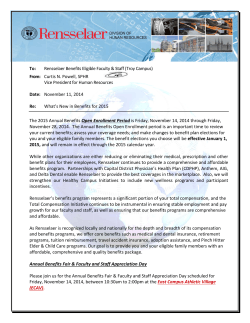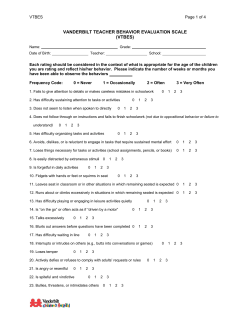
Wake County Academically Gifted Program
Wake County Public School System Academically Or Intellectually Gifted Program Washington Elementary Bob Grant Bill Bastin 1 Wake County Public School System Vision: WCPSS will serve as the national standard for increasing student achievement in the 21st century. • Highly effective teachers and principals are empowered to raise the achievement of all children and will provide students with high quality classroom instruction that fosters intellectual development. WCPSS recognizes children have different needs. • WCPSS is committed to ensuring all students are challenged to reach their full potential and to be held accountable partners in their learning. Students will graduate in increasingly higher percentages and compete successfully as productive citizens. 2 WCPSS AIG Updates 2014-2015 AIG Plan 2013-2016 ◦Year 1, Implementation Year 3 AIG Service Delivery Students identified as AIG receive differentiated services at all Wake County Public Schools. Each school develops their AIG Plan outlining service delivery. Schools choose from a variety of service options. 4 AIG Program Service Options K-2 Program Details Students in Kindergarten through 2nd grade receive differentiation and enrichment opportunities via the classroom teacher. AIG teachers consult and collaborate with gradelevels to provide resources to ensure each student has enrichment opportunities aligned with the gradelevel Common Core Standard. Nurturing Program for students in Pilot Schools At Washington we have our wonderful Magnet program. 5 AIG Program Service Options Magnet Electives: In-house recommendation Identification 6 AIG Program Service Options 3rd Grade Explorers Model AIG teacher collaborates with 3rd grade teachers to provide a variety of in-class experiences for all students. The AIG teacher will provide educational experiences in the following: ◦ Critical Thinking ◦ Mathematics ◦ English/Language Arts Cogat exposure Helps identify for in-house recommendation 7 4th-8th Grade Service Delivery Students are served through the following: Differentiated Instructional Units In-Class Flexible Grouping Cluster Grouping Co-Teaching- myself and Ms. Bledsoe will collaborate with teachers to develop rigorous instruction methods in the classroom. High School Students Students self-select advanced courses. At Washington the AIG service is delivered through the electives and some in-class instruction. 8 Traditional Identification Process Screening of all WCPSS 3rd grade students Parent nominations, grade 4-8 Teacher nominations, grade 4-8 Student nominations 9 Nomination Windows Nominations are accepted at any time. Nominations are reviewed before the semester testing dates. Nominated students will be referred for evaluation based on current data. Nomination Posters are posted throughout the school. 10 Testing Dates Testing dates are scheduled: First Semester: in week 6 of the 1st quarter Second Semester: in week 4 of the 3rd quarter Nominations received after the testing deadline will be considered during the next semester. 11 AIG Referral – 4-8 Referred students are administered the Cognitive Abilities Test and the Iowa Assessments. Data is complied on an Individual Student Profile (ISP). Informal Indicators Formal Indicators (Norm referenced assessments) Current aptitude scores • Current achievement scores • Current scores are scores within one calendar year of each other and obtained after 2nd grade. SBCGE reviews the complete student profile to make a recommendation. 12 Informal Indicators Learning Behaviors ◦ Parent and teacher checklists Student Performance ◦ Parent and teacher checklists ◦ Current academic grades in ELA and Math ◦ Current portfolio work samples in ELA and Math Student Interest ◦ Parent and teacher checklists Student Motivation ◦ Parent and teacher checklists Other Informal Indicators ◦ GRS, Anecdotal Records, Projects, Awards, EOG Scores 13 AIG School Based Committee for Gifted Education (SBCGE) • Provides a team framework for evaluating data and recommending the most appropriate service for individual students who demonstrate a need for differentiation • Includes administrator, AIG teacher, and staff members representative of core content areas and/or grade levels at each school. • Makes recommendations regarding: AIG referral, AIG identification, AIG services, and any issues involving identified AIG students. 14 Formal Indicators Norm Referenced Assessments Aptitude test scores ◦ Cognitive Abilities Test (CogAT) ◦ Individual tests administered as necessary Achievement test scores Iowa Assessments (IA) Individual tests administered as necessary 15 16 Gateway #1 Gateway #2 Gateway #3 GATEWAY Identification Measures Students scoring > 95% on both a qualifying CogAT score AND Iowa total reading and/or total math score are identified in the area(s) in which the scores align Students scoring >95% on qualifying CogAT score AND <95% on Iowa reading and/or math The WJ III is administered in reading and/or math. The achievement areas administered are determined by the qualifying CogAT score. Students scoring > 95% on the WJ III paired with a qualifyinq CogAT score are identified in the area(s) in which the scores align Students scoring scoring >95% on Iowa reading and/or math and <95% on a qualifying CogAT score Either the Reynolds Intellectual Screening Test (RIST) OR the Raven Standard Progressive Matrices is administered. Students scoring > 95% on the individual aptitude (RIST or Raven) paired with the Iowa reading and/or math are identified in the area(s) in which the scores align > 98% on Iowa reading and/or math > 98% on EOG/EOC scores in reading and/or math from the current or the previous school year which align with qualifying Iowa score Students are identified in the area(s) in which the scores align Students scoring >95% on a qualifying CogAT > 95% on EOG/EOC scores in reading and/or math from the current or the previous school year which align with qualifying CogAT score A GRS with scores >88% in three of the five scales. Students scoring > 95% on the Iowa Assessments in reading and /or math > 95% on EOG/EOC scores in reading and/or math from the current or the previous school year which align with qualifying Iowa score A GRS with scores >88% in three of the five scales. Student’s portfolio data demonstrates consistent performance 1-2 grade levels above the student’s current grade Referral made by the SBCGE for an individual psychological evaluation. This evaluation may include individual aptitude and/ or achievement assessments. > 98% on CogAT Composite or Partial Composite are identified in reading and math Gateway #4 Gateway #5 Students are idenified in the area(s) in which the scores align Students are idenified in the area(s) in which the scores align For specific identification criteria for Gateway #5, see AIG Identification Table 17 Gateway 1 Students scoring > 95% on both a qualifying CogAT AND IOWA total reading and/or total math score are identified in the area(s) in which the scores align. 18 Gateway 2 Students scoring > 95% on qualifying CogAT score AND < 95% on Iowa reading and/or math, the most recent version of the Woodcock Johnson Achievement Test (WJ) is administered in reading and/or math. The achievement areas administered are determined by the qualifying CogAT score. Students scoring > on the WJ paired with a qualifying CogAT score are identified in the area(s) in which the scores align. 19 Gateway 2 • Students scoring > 95% on Iowa reading and/or math and <95% on a qualifying CogAT score, either the Reynolds Intellectual Screening Test (RIST) OR the Raven Standard Progressive Matrices is administered • Students scoring >95 on the individual aptitude (RIST or Raven) paired with the Iowa reading and/or math are identified in the area(s) in which the scores align. 20 Gateway 3 > 98% on CogAT Composite or Partial Composite are identified in reading and/or math. 21 Gateway 3 > 98% on Iowa Reading and/or Math AND > 98% on EOG/EOC scores in reading and/or math from the current or the previous school year which align with qualifying Iowa score Students are identified in the area(s) in which the scores align. 22 Gateway 4 Students scoring >95% on a qualifying CogAT, > 95% on EOG/EOC scores in reading and/or math from the current or the previous school year which align with the qualifying CogAT score AND GRS with scores >88% in three of the five scales. Students are identified in the area(s) in which the scores align. 23 Gateway 4 Students scoring > 95% on the Iowa Assessments in reading and/or math AND >95% on EOG/EOC scores in reading and/or math from the current or the previous school year which align with qualifying Iowa score AND a GRS with scores >88% in three of the five scales are identified in the area(s) in which the scores align. 24 The Gifted Rating Scales, first published in 2003, are authored by Steven Ira Pfeiffer, PhD (1950-), and Tania Jarosewich, PhD. The GRS is completed through teacher evaluations and measures giftedness on multiple scales. The GRS-P, designed for children in preschool and kindergarten, evaluates children on five scales: Intellectual ability Academic ability Creativity Artistic talent Motivation 25 Gateway 5 Students’ portfolio data demonstrates consistent performance 1-2 grade levels above the student’s current grade are referred by the SBCGE for an individual psychological evaluation. This evaluation may include individual aptitude and/or achievement assessments. For specific identification criteria for Gateway #5, see AIG Identification Table. 26 SBCGE Decision Not Recommended for AIG Differentiation Recommended for AIG Differentiation in Language Arts and/or Mathematics SBCGE reviews student performance annually. 27 Differentiated Education Plan Differentiated Course Plan Differentiated Education Plan (DEP) • Describes the AIG Program services at your school • Reflects appropriate service delivery options • Outlines AIG Progress Report for 4th and 5th grade • Documents the results of the annual review process 28 Differentiated Curriculum & Instruction Cluster grouping Flexible grouping Curriculum compacting Differentiated instructional units/centers Increased complexity and challenge Tiered activities and assignments Varied texts and materials Projects and investigations Technology applications 29 Stakeholders for AIG Student Success AIG Teacher Classroom Teacher Parents Student AIG Central Services Staff Administrators, Counselors & Other School Staff 30 Additional Information is Available From: abastin@WCPSS.NET School websites and newsletters WCPSS website AIG Brochure (provided to all 3rd grade families) 31
© Copyright 2025









